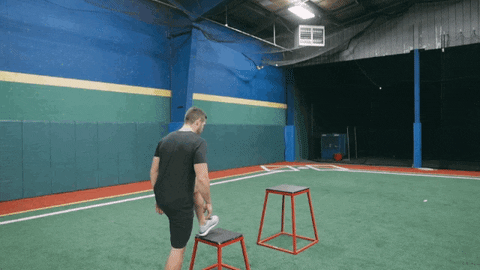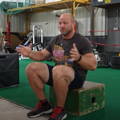Best Plyometric Workout for Athletes
FREE SPEED & POWER WORKOUT!
Download by entering below

The Best Exercises For Explosive Power
Doing plyometrics for athletes and the general population is great for improving joint stiffness and elasticity when jumping and producing a ton of force. Elasticity is improved from plyometric-based training will lead to great force production, force absorption, put out larger amounts of force sprinting, and in turn, will help change direction quicker.
Plyometric-based training can also help bust through lifting plateaus. Plyometrics also help improve the rate of coordination. Talking about general fitness individuals, plyometrics help prevents falls or help the person fall effectively. In turn, people are learning how to slow down the fastest which is a big skill for the athletic realm. Learning how to slow down the fastest improves agility and the ability to change direction.

In introducing plyometric movements to increase explosive power, we have to start with low-level plyometrics. The first key step is to use something as simple as PVC pipe walks to wake up the feet and calf muscles by going forward, backward, fast, and slow. After the PVC pipe walks, the next step is doing some heel walks, heel-to-toe walks, and forward and backward plantar flexion walks. Each movement is a gradual level increase in plyometric movement. So the next movement to do is simple bunny hops. Focus on almost grounding flat-footed but not letting the foot go flat. In the air, we want to dorsiflex. A nice, low-level plyometric movement that a lot of athletes and a lot of general population fitness enthusiasts can do to wake up the feet.

1. Seated Box Jump
We want to build into a movement with more moderate intensity. The seated box jumps require starting from a static position forcing the body to learn how to engage the quads, hamstrings, and glutes to be explosive. The movement can be done for five sets of two reps.

2. Side Jumps On One Leg
This moderate-intensity plyometric movement is unilaterally based. It will help dynamic trunk control, deceleration, and the ability to absorb force. Jump laterally over a mini hurdle. Jump off the leg furthest away from the hurdle. Land on the opposite leg and pause in the landing. After establishing a solid ground, jump again. The jumping goes from side to side, leg to leg.
Coaches need to pay attention to how the athletes land and absorb the force. Then, when programming strength-based movements, target the areas needed to prevent flubs from occurring.
3. Single Leg Bounds
Single-leg bounds, one of my favorites, is a high-intensity plyometric exercise to drastically improve explosive power. It carries over well to any sport with locomotion. The other thing it does is train impulses. Impulse is force over time. Thinking about blast impulse, which is very quick, requires producing a lot of force in a very brief amount of time repeatedly.
Another exercise that is great for general population athletes is skipping for height or skips for distance. Both movements help train central pattern generators and target specific impulse-based training.
4. Cuts Into Hurdle Hops
When doing advanced movements, we will pair unilateral exercises with bilateral exercises. My favorite bilateral plyometric is hurdle hops. A great way to make an advanced movement like hurdle hops more complicated is by putting in a unilateral aspect.
For instance, start on one leg. Jump laterally off one leg over a mini hurdle, land on two legs, and then jump over a high hurdle. Upon landing on two legs, jump laterally in the opposite direction over a mini hurdle, land on the other leg and immediately jump back over the mini-hurdle, land on two feet and again jump over a high hurdle.

The exercise is great for agility, cutting, change of direction, and learning how to absorb force, which carries over well to competitive play.
When To Use Plyometrics In Training
Plyometrics should be used during the athlete day (day 3), a day almost exclusively reserved for plyometrics and reflexive movements, or impulse day (day 4), where there is a focus on creating a lot of force in a short period.
Looking at our blocks: exposure, comprehension, ascension, and summit. The realization phase is not mentioned because typically we back out of all plyometric-based training. During the exposure and comprehension phase, we want to use simpler plyometric movements with higher volume. As we get into the ascension and summit phases, we want to use more advanced plyometric movements with more specific exercises that transfer to an athlete’s sport.
Recap
Plyometrics can help both athletes and the general population. It is also to develop plyometric capabilities by building in intensity from low, moderate, to advanced intensities. Also, make sure to use plyometric movements on the athlete day and impulse days of training. Remember, always cultivate your power!
Related Posts
Blog Topics

Yo, It's Dane
Welcome to the Garage Strength Blog, where it is my goal to provide you with the experience and knowledge I've gained in the strength and conditioning world over many years of learning from both successes and failures. I train elite-level athletes in a multitude of sports from the high school to professional levels, already producing 5 Olympics and 30+ National Champions. If you want to be the next champion I train, check out my strength programs below!
Start Training With Me

Join for free educational videos EVERY WEEK on strength coaching and athletic performance



